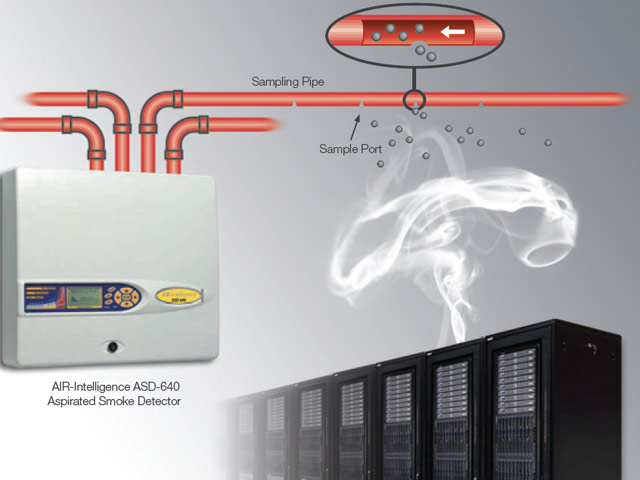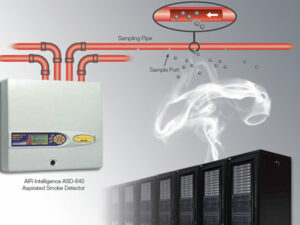
How Does an Aspirating Smoke Detector Work
Aspirating smoke detectors work by actively drawing air from the environment into a specialized detection chamber. Within this chamber, highly sensitive sensors analyze the air for even the smallest smoke particles. This early detection capability ensures rapid response to potential fire hazards, providing a crucial advantage in safeguarding lives and property.
In the realm of fire safety, early detection can make all the difference between a minor incident and a catastrophic disaster. Smoke detectors play a critical role in ensuring the safety of occupants in homes, offices, and industrial facilities. Among the various types of smoke detectors, aspirating smoke detectors stand out for their ability to provide highly sensitive and early smoke detection. In this comprehensive guide, we will delve into the intricate workings of aspirating smoke detectors, answering the question: “How does an aspirating smoke detector work?”
Understanding Smoke Detection Basics
The Role of Smoke Detectors in Fire Safety
Smoke detectors are the unsung heroes of fire safety. They are devices designed to detect the presence of smoke, a common precursor to fires, and trigger an alarm, warning occupants of potential danger. Smoke detectors are a fundamental component of fire prevention and protection systems.
Introduction to Aspirating Smoke Detectors
Aspirating smoke detectors, also known as air-sampling smoke detectors, take smoke detection to the next level. They are specialized devices designed to provide early and highly accurate smoke detection in various environments, including those with challenging conditions such as high ceilings, extreme temperatures, or areas with limited accessibility.
What Is an Aspirating Smoke Detector?
Definition and Purpose
An aspirating smoke detector is a sophisticated system that actively samples air from the environment and analyzes it for the presence of smoke particles. Its primary purpose is to provide early warning of fires, allowing for timely response and evacuation, ultimately saving lives and protecting property.
Key Components of an Aspirating Smoke Detection System
-
Sampling Pipes
At the heart of an aspirating smoke detector is a network of sampling pipes that draw air from the protected area to the detection chamber. These pipes are strategically placed to ensure comprehensive coverage.
-
Airflow System
The airflow system is responsible for transporting air from the sampling pipes to the smoke detection chamber. The controlled airflow is crucial for accurate smoke detection.
-
Smoke Detection Chamber
The smoke detection chamber is where the magic happens. It contains sensors that can detect even the smallest smoke particles. This chamber is the critical element responsible for the system’s sensitivity.
-
Alarm Panel
The alarm panel is the brain of the aspirating smoke detection system. It receives signals from the smoke detection chamber, processes them, and activates alarms when smoke is detected. It can also integrate with existing fire alarm systems.
The Operation of an Aspirating Smoke Detector
Air Sampling Process
-
Explanation of the Air Sampling Process
The operation begins with the air sampling process. A small amount of air is continually drawn into the system through the sampling pipes. This air is then passed through the smoke detection chamber.
-
How Air Is Drawn Into the System
The mechanism that draws air into the system can vary. Some aspirating smoke detectors use a fan, while others rely on the natural airflow in the environment. The choice depends on the specific application and requirements.
-
The Importance of Airflow in Detection
Controlled airflow ensures that air from all parts of the protected area is sampled, increasing the system’s effectiveness in detecting smoke at an early stage.
Smoke Detection Chamber
-
How Smoke Is Detected Within the Chamber
Inside the smoke detection chamber, advanced sensors, such as laser or photoelectric detectors, are used to analyze the air for the presence of smoke particles. These sensors are highly sensitive and can detect even tiny smoke particles.
-
Sensitivity Settings
Aspirating smoke detectors often allow for sensitivity adjustments to adapt to different environments. This flexibility ensures that the system can detect smoke accurately without triggering false alarms.
Alarm Panel and Notification
-
How the Alarm Panel Processes Detection Signals
When smoke particles are detected, the alarm panel processes the signals and activates the alarm system. This can include audible alarms, visual alerts, and remote notifications, ensuring that occupants are promptly alerted to the presence of smoke.
-
Integration with Fire Alarm Systems
Aspirating smoke detection systems can be seamlessly integrated with existing fire alarm systems, enhancing overall fire safety and emergency response capabilities.
Benefits of Aspirating Smoke Detectors
Early Warning
-
Advantages of Early Smoke Detection
The primary advantage of aspirating smoke detectors is their ability to provide extremely early warning of smoke, often well before traditional detectors would trigger an alarm. This can be a lifesaver in critical situations.
-
Reducing False Alarms
The high sensitivity of aspirating smoke detectors is balanced by their ability to differentiate between harmless particles and actual smoke, reducing the likelihood of false alarms.
Applications and Environments for Aspirating Smoke Detection
Aspirating smoke detectors excel in specific environments and situations:
-
Data Centers
Data centers house critical infrastructure, and early smoke detection is paramount to prevent damage to servers and data loss.
-
Museums and Art Galleries
Preserving valuable artifacts and artworks requires a fire detection system that is both sensitive and non-invasive, making aspirating smoke detectors an ideal choice.
-
Clean Rooms
In clean rooms used for sensitive manufacturing processes, even minute particles of smoke can disrupt operations. Aspirating smoke detectors maintain air quality and safety.
-
High Ceilings and Atria
Traditional detectors may struggle in spaces with high ceilings or open atria, where smoke dispersion is challenging. Aspirating smoke detectors overcome these obstacles.
-
Challenging Environments
Aspirating smoke detectors perform reliably in environments with high dust levels, humidity, or extreme temperatures where traditional detectors might fail.
Bespoke Aspirating Smoke Detection with Cobra Fire & Security
When it comes to implementing aspirating smoke detection systems tailored to your unique needs, look no further than Cobra Fire & Security. Our team of experts specializes in designing and installing bespoke aspirating smoke detection solutions that provide the highest level of fire safety for your specific environment.
Contact us today to discuss your aspirating smoke detection requirements and ensure the safety and security of your premises. Your safety is our top priority.
Maintenance and Testing of Aspirating Smoke Detection
-
Routine Maintenance Requirements
To ensure the continued reliability of an aspirating smoke detection system, regular maintenance is essential. This includes checking air sampling pipes, cleaning the detection chamber, and testing the system.
-
Importance of Regular Testing
Regular testing ensures that the system operates as intended. Some systems offer self-testing capabilities, simplifying this crucial maintenance task.
Comparing Aspirating Smoke Detectors to Conventional Detectors
Advantages over Traditional Smoke Detectors
Aspirating smoke detectors offer several advantages over traditional smoke detectors, including:
- Earlier detection
- Reduced false alarms
- Better performance in challenging environments
Cost Considerations
While aspirating smoke detectors provide enhanced capabilities, they can be more expensive than conventional detectors. However, their benefits often justify the investment, particularly in critical applications.
Suitability for Specific Applications
The suitability of aspirating smoke detectors depends on the specific requirements of an environment. Understanding your needs is crucial in determining whether this technology is the right choice for your fire safety system.
Conclusion
In conclusion, aspirating smoke detectors are a remarkable advancement in fire safety technology. Their ability to provide early and highly accurate smoke detection can make a significant difference in preventing fire-related disasters. Whether you’re protecting a data center, a museum, or an industrial facility, considering the use of aspirating smoke detectors is a wise choice for enhancing fire safety.
Reviewed: 26/09/2023 Our articles are reviewed regularly. However, any changes made to standards or legislation following the review date will not have been considered. Please note that we provide abridged, easy-to-understand guidance. To make detailed decisions about your fire safety provisions, you might require further advice or need to consult the full standards and legislation.
Share this article
Written by : Michael Winter
Follow us
A quick overview of the topics covered in this article.
- Understanding Smoke Detection Basics
- What Is an Aspirating Smoke Detector?
- The Operation of an Aspirating Smoke Detector
- Benefits of Aspirating Smoke Detectors
- Applications and Environments for Aspirating Smoke Detection
- Bespoke Aspirating Smoke Detection with Cobra Fire & Security
- Maintenance and Testing of Aspirating Smoke Detection
- Comparing Aspirating Smoke Detectors to Conventional Detectors
- Conclusion
Latest articles
July 27, 2024
July 27, 2024
July 27, 2024



